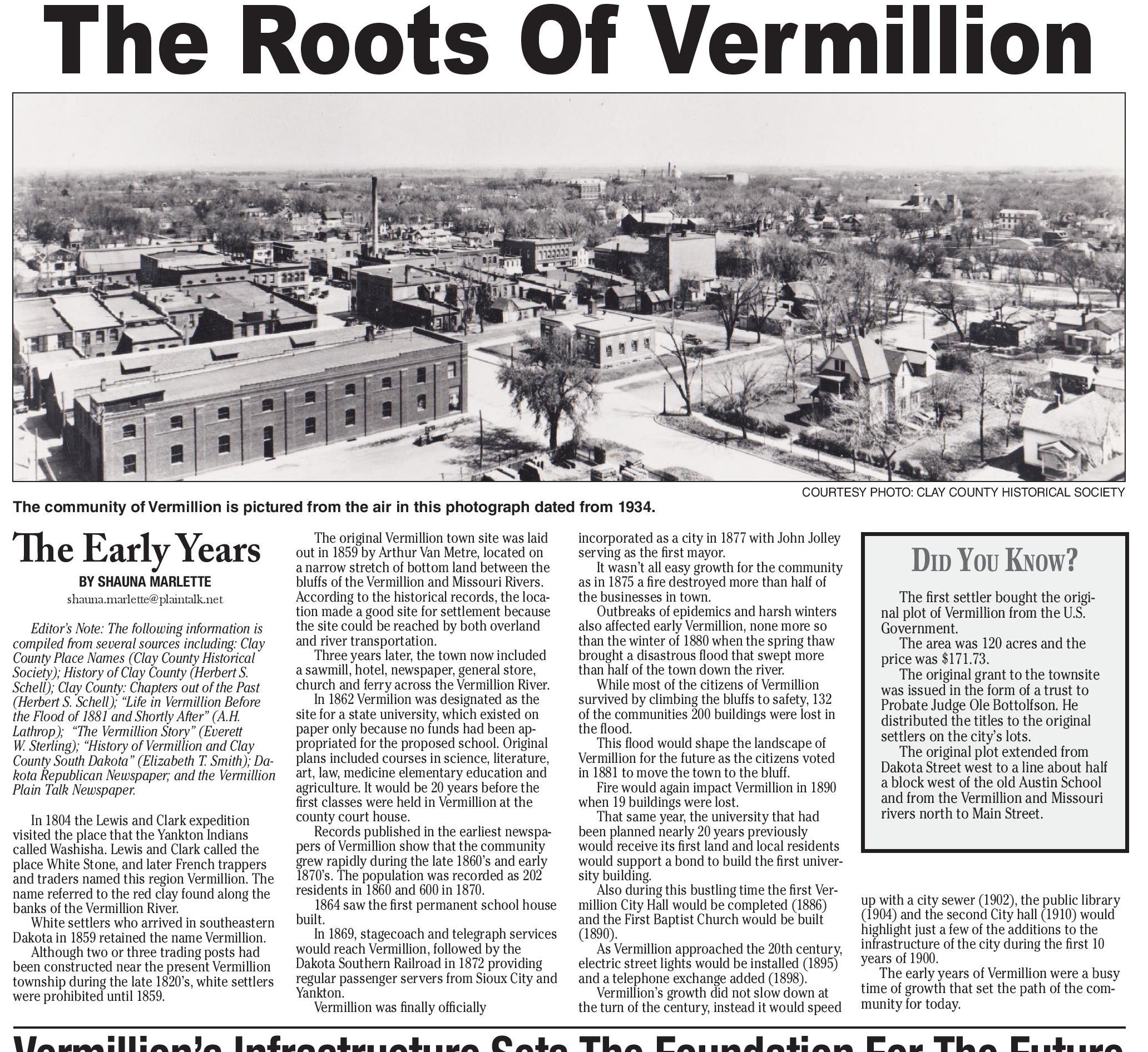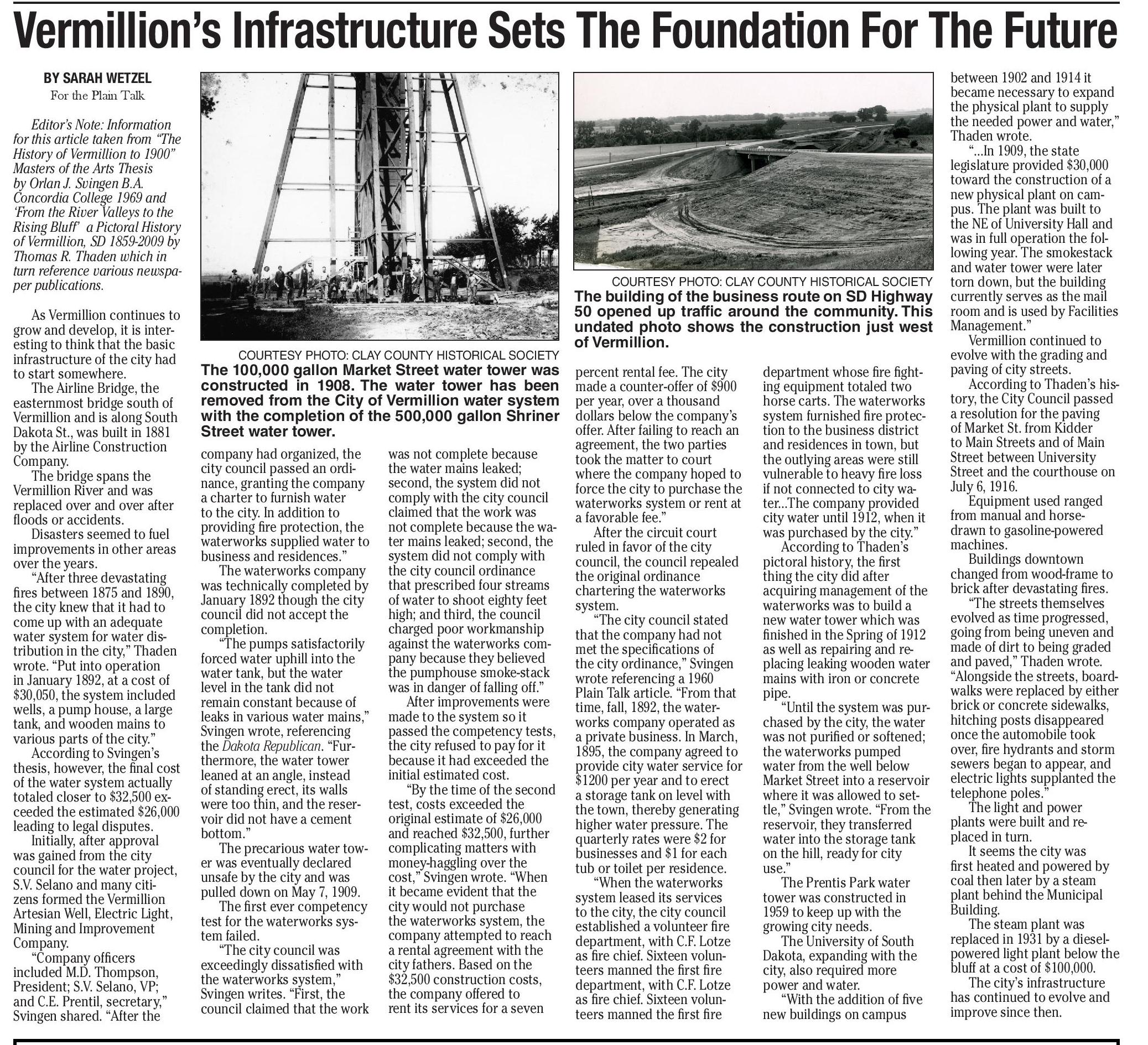112015_YKPT_B2.pdf



2B Heritage 2015
November 20, 2015 www.plaintalk.net
The Roots Of Vermillion
COURTESY PHOTO: CLAY COUNTY HISTORICAL SOCIETY
The community of Vermillion is pictured from the air in this photograph dated from 1934.
The Early Years
BY SHAUNA MARLETTE
shauna.marlette@plaintalk.net
Editor’s Note: The following information is
compiled from several sources including: Clay
County Place Names (Clay County Historical
Society); History of Clay County (Herbert S.
Schell); Clay County: Chapters out of the Past
(Herbert S. Schell); “Life in Vermillion Before
the Flood of 1881 and Shortly After” (A.H.
Lathrop); “The Vermillion Story” (Everett
W. Sterling); “History of Vermillion and Clay
County South Dakota” (Elizabeth T. Smith); Dakota Republican Newspaper; and the Vermillion
Plain Talk Newspaper.
In 1804 the Lewis and Clark expedition
visited the place that the Yankton Indians
called Washisha. Lewis and Clark called the
place White Stone, and later French trappers
and traders named this region Vermillion. The
name referred to the red clay found along the
banks of the Vermillion River.
White settlers who arrived in southeastern
Dakota in 1859 retained the name Vermillion.
Although two or three trading posts had
been constructed near the present Vermillion
township during the late 1820’s, white settlers
were prohibited until 1859.
The original Vermillion town site was laid
out in 1859 by Arthur Van Metre, located on
a narrow stretch of bottom land between the
bluffs of the Vermillion and Missouri Rivers.
According to the historical records, the location made a good site for settlement because
the site could be reached by both overland
and river transportation.
Three years later, the town now included
a sawmill, hotel, newspaper, general store,
church and ferry across the Vermillion River.
In 1862 Vermilion was designated as the
site for a state university, which existed on
paper only because no funds had been appropriated for the proposed school. Original
plans included courses in science, literature,
art, law, medicine elementary education and
agriculture. It would be 20 years before the
first classes were held in Vermillion at the
county court house.
Records published in the earliest newspapers of Vermillion show that the community
grew rapidly during the late 1860’s and early
1870’s. The population was recorded as 202
residents in 1860 and 600 in 1870.
1864 saw the first permanent school house
built.
In 1869, stagecoach and telegraph services
would reach Vermillion, followed by the
Dakota Southern Railroad in 1872 providing
regular passenger servers from Sioux City and
Yankton.
Vermillion was finally officially
incorporated as a city in 1877 with John Jolley
serving as the first mayor.
It wasn’t all easy growth for the community
as in 1875 a fire destroyed more than half of
the businesses in town.
Outbreaks of epidemics and harsh winters
also affected early Vermillion, none more so
than the winter of 1880 when the spring thaw
brought a disastrous flood that swept more
than half of the town down the river.
While most of the citizens of Vermillion
survived by climbing the bluffs to safety, 132
of the communities 200 buildings were lost in
the flood.
This flood would shape the landscape of
Vermillion for the future as the citizens voted
in 1881 to move the town to the bluff.
Fire would again impact Vermillion in 1890
when 19 buildings were lost.
That same year, the university that had
been planned nearly 20 years previously
would receive its first land and local residents
would support a bond to build the first university building.
Also during this bustling time the first Vermillion City Hall would be completed (1886)
and the First Baptist Church would be built
(1890).
As Vermillion approached the 20th century,
electric street lights would be installed (1895)
and a telephone exchange added (1898).
Vermillion’s growth did not slow down at
the turn of the century, instead it would speed
Did You Know?
The first settler bought the original plot of Vermillion from the U.S.
Government.
The area was 120 acres and the
price was $171.73.
The original grant to the townsite
was issued in the form of a trust to
Probate Judge Ole Bottolfson. He
distributed the titles to the original
settlers on the city’s lots.
The original plot extended from
Dakota Street west to a line about half
a block west of the old Austin School
and from the Vermillion and Missouri
rivers north to Main Street.
up with a city sewer (1902), the public library
(1904) and the second City hall (1910) would
highlight just a few of the additions to the
infrastructure of the city during the first 10
years of 1900.
The early years of Vermillion were a busy
time of growth that set the path of the community for today.
Vermillion’s Infrastructure Sets The Foundation For The Future
BY SARAH WETZEL
For the Plain Talk
Editor’s Note: Information
for this article taken from “The
History of Vermillion to 1900”
Masters of the Arts Thesis
by Orlan J. Svingen B.A.
Concordia College 1969 and
‘From the River Valleys to the
Rising Bluff’ a Pictoral History
of Vermillion, SD 1859-2009 by
Thomas R. Thaden which in
turn reference various newspaper publications.
As Vermillion continues to
grow and develop, it is interesting to think that the basic
infrastructure of the city had
to start somewhere.
The Airline Bridge, the
easternmost bridge south of
Vermillion and is along South
Dakota St., was built in 1881
by the Airline Construction
Company.
The bridge spans the
Vermillion River and was
replaced over and over after
floods or accidents.
Disasters seemed to fuel
improvements in other areas
over the years.
“After three devastating
fires between 1875 and 1890,
the city knew that it had to
come up with an adequate
water system for water distribution in the city,” Thaden
wrote. “Put into operation
in January 1892, at a cost of
$30,050, the system included
wells, a pump house, a large
tank, and wooden mains to
various parts of the city.”
According to Svingen’s
thesis, however, the final cost
of the water system actually
totaled closer to $32,500 exceeded the estimated $26,000
leading to legal disputes.
Initially, after approval
was gained from the city
council for the water project,
S.V. Selano and many citizens formed the Vermillion
Artesian Well, Electric Light,
Mining and Improvement
Company.
“Company officers
included M.D. Thompson,
President; S.V. Selano, VP;
and C.E. Prentil, secretary,”
Svingen shared. “After the
COURTESY PHOTO: CLAY COUNTY HISTORICAL SOCIETY
COURTESY PHOTO: CLAY COUNTY HISTORICAL SOCIETY
The 100,000 gallon Market Street water tower was
constructed in 1908. The water tower has been
removed from the City of Vermillion water system
with the completion of the 500,000 gallon Shriner
Street water tower.
company had organized, the
city council passed an ordinance, granting the company
a charter to furnish water
to the city. In addition to
providing fire protection, the
waterworks supplied water to
business and residences.”
The waterworks company
was technically completed by
January 1892 though the city
council did not accept the
completion.
“The pumps satisfactorily
forced water uphill into the
water tank, but the water
level in the tank did not
remain constant because of
leaks in various water mains,”
Svingen wrote, referencing
the Dakota Republican. “Furthermore, the water tower
leaned at an angle, instead
of standing erect, its walls
were too thin, and the reservoir did not have a cement
bottom.”
The precarious water tower was eventually declared
unsafe by the city and was
pulled down on May 7, 1909.
The first ever competency
test for the waterworks system failed.
“The city council was
exceedingly dissatisfied with
the waterworks system,”
Svingen writes. “First, the
council claimed that the work
was not complete because
the water mains leaked;
second, the system did not
comply with the city council
claimed that the work was
not complete because the water mains leaked; second, the
system did not comply with
the city council ordinance
that prescribed four streams
of water to shoot eighty feet
high; and third, the council
charged poor workmanship
against the waterworks company because they believed
the pumphouse smoke-stack
was in danger of falling off.”
After improvements were
made to the system so it
passed the competency tests,
the city refused to pay for it
because it had exceeded the
initial estimated cost.
“By the time of the second
test, costs exceeded the
original estimate of $26,000
and reached $32,500, further
complicating matters with
money-haggling over the
cost,” Svingen wrote. “When
it became evident that the
city would not purchase
the waterworks system, the
company attempted to reach
a rental agreement with the
city fathers. Based on the
$32,500 construction costs,
the company offered to
rent its services for a seven
The building of the business route on SD Highway
50 opened up traffic around the community. This
undated photo shows the construction just west
of Vermillion.
percent rental fee. The city
made a counter-offer of $900
per year, over a thousand
dollars below the company’s
offer. After failing to reach an
agreement, the two parties
took the matter to court
where the company hoped to
force the city to purchase the
waterworks system or rent at
a favorable fee.”
After the circuit court
ruled in favor of the city
council, the council repealed
the original ordinance
chartering the waterworks
system.
“The city council stated
that the company had not
met the specifications of
the city ordinance,” Svingen
wrote referencing a 1960
Plain Talk article. “From that
time, fall, 1892, the waterworks company operated as
a private business. In March,
1895, the company agreed to
provide city water service for
$1200 per year and to erect
a storage tank on level with
the town, thereby generating
higher water pressure. The
quarterly rates were $2 for
businesses and $1 for each
tub or toilet per residence.
“When the waterworks
system leased its services
to the city, the city council
established a volunteer fire
department, with C.F. Lotze
as fire chief. Sixteen volunteers manned the first fire
department, with C.F. Lotze
as fire chief. Sixteen volunteers manned the first fire
department whose fire fighting equipment totaled two
horse carts. The waterworks
system furnished fire protection to the business district
and residences in town, but
the outlying areas were still
vulnerable to heavy fire loss
if not connected to city water...The company provided
city water until 1912, when it
was purchased by the city.”
According to Thaden’s
pictoral history, the first
thing the city did after
acquiring management of the
waterworks was to build a
new water tower which was
finished in the Spring of 1912
as well as repairing and replacing leaking wooden water
mains with iron or concrete
pipe.
“Until the system was purchased by the city, the water
was not purified or softened;
the waterworks pumped
water from the well below
Market Street into a reservoir
where it was allowed to settle,” Svingen wrote. “From the
reservoir, they transferred
water into the storage tank
on the hill, ready for city
use.”
The Prentis Park water
tower was constructed in
1959 to keep up with the
growing city needs.
The University of South
Dakota, expanding with the
city, also required more
power and water.
“With the addition of five
new buildings on campus
HERREN•SCHEMPP
BUILDING SUPPLY
M-F 7:30am - 5:30pm
Sat 7:30am - 5:00pm
• Building Materials
• Cabinets & Counters
• Windows & Doors
• Siding & Roofing
• Deck & Railing
between 1902 and 1914 it
became necessary to expand
the physical plant to supply
the needed power and water,”
Thaden wrote.
“...In 1909, the state
legislature provided $30,000
toward the construction of a
new physical plant on campus. The plant was built to
the NE of University Hall and
was in full operation the following year. The smokestack
and water tower were later
torn down, but the building
currently serves as the mail
room and is used by Facilities
Management.”
Vermillion continued to
evolve with the grading and
paving of city streets.
According to Thaden’s history, the City Council passed
a resolution for the paving
of Market St. from Kidder
to Main Streets and of Main
Street between University
Street and the courthouse on
July 6, 1916.
Equipment used ranged
from manual and horsedrawn to gasoline-powered
machines.
Buildings downtown
changed from wood-frame to
brick after devastating fires.
“The streets themselves
evolved as time progressed,
going from being uneven and
made of dirt to being graded
and paved,” Thaden wrote.
“Alongside the streets, boardwalks were replaced by either
brick or concrete sidewalks,
hitching posts disappeared
once the automobile took
over, fire hydrants and storm
sewers began to appear, and
electric lights supplanted the
telephone poles.”
The light and power
plants were built and replaced in turn.
It seems the city was
first heated and powered by
coal then later by a steam
plant behind the Municipal
Building.
The steam plant was
replaced in 1931 by a dieselpowered light plant below the
bluff at a cost of $100,000.
The city’s infrastructure
has continued to evolve and
improve since then.
1000 West Cherry Street
Vermillion, SD 57069
herrenschempp.com
(605) 624-2058
(888) 624-2058
• Paint
• Kitchen & Bath Design
• Material Estimation
• Free Delivery
Locally Owned for the Builder & Handyman!
















 Previous Page
Previous Page






